
- SEARCH
-
Purchase CardCart
( 0 )
My Purchase Card
0 ITEMS IN YOUR BASKET

| Introduction | ||||
| PM 1 | PM 6 | PM 11 | PM 16 | PM 30 |
| PM 2 | PM 7 | PM 12 | PM 17 | PM 31 |
| PM 4 | PM 8 | PM 13 | PM 25-27 | PM 32-35 |
| PM B4 | PM 9 | PM 14 | PM 28 | PM 33 |
| PM 5 | PM 10 | PM 15 | PM 29 | PM Other |
Postmark Type 4
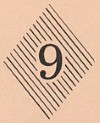 Description PM type 4 (JC-MN-RF) Diamond of parallel bars numbered between 9 12, usually ascending from right to left with numeral inset not in duplex. So prolific was its use that many subtypes exist with differing sizes, shape variations, an array of numeral fonts. Subtypes 4c to 4o are all found only on DLR post 1855 stamps, including some in duplex form Many are considered common.
Description PM type 4 (JC-MN-RF) Diamond of parallel bars numbered between 9 12, usually ascending from right to left with numeral inset not in duplex. So prolific was its use that many subtypes exist with differing sizes, shape variations, an array of numeral fonts. Subtypes 4c to 4o are all found only on DLR post 1855 stamps, including some in duplex form Many are considered common.From Bombay postal sub-region, extensively used 1855 onwards until 1861, prior to PM type 9 introduction. This postal jurisdiction covered a wide geographical area, including Sind, more western parts of Central India, Used abroad in Persian Gulf, as well as Maharashtra, and Gujarat states. See separate section below for Bombay Urban types (B4) of the same design.
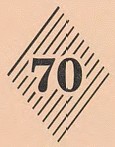 PM subtype 4a Cooper considered this type as an error with normally 11 lines (not in a duplex) ascending from left to right also found with 8,9,10, 12 bars. Not to be confused with part of duplex in PM type 10. Very scarce.
PM subtype 4a Cooper considered this type as an error with normally 11 lines (not in a duplex) ascending from left to right also found with 8,9,10, 12 bars. Not to be confused with part of duplex in PM type 10. Very scarce.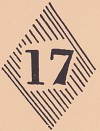 PM subtype 4b An attempt to make larger obliterator with large clumsy or irregular figures 2mm higher than most normal PM type 4 examples Fairly scarce.
PM subtype 4b An attempt to make larger obliterator with large clumsy or irregular figures 2mm higher than most normal PM type 4 examples Fairly scarce.PM subtypes 4c Diamond commonly numbering 13 lines, although it can vary from 9 to 14 lines. Fairly regular distinct font type usually about 6mm high not with clearly defined inset. Considered an attempt in the latter part of 1863 to prepare a smaller well-defined cancellation. In my view it is a quite generic non-distinctive type encompassing a number of subtle variations.
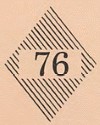 PM subtypes 4d-4f This group have smaller dimensions with mostly fine lines, and usually well-defined numeral insets. 4d & 4f (Image 4e) were designed to accommodate 3 numerals, as a greater amount of post offices were allocated numbers between 100 up to 419 (Highest number PO recorded by Martin) They can range from common to scarce.
PM subtypes 4d-4f This group have smaller dimensions with mostly fine lines, and usually well-defined numeral insets. 4d & 4f (Image 4e) were designed to accommodate 3 numerals, as a greater amount of post offices were allocated numbers between 100 up to 419 (Highest number PO recorded by Martin) They can range from common to scarce.PM subtype 4g Small narrow width diamond with only 11-12 lines not a duplex, and well-defined numeral inset. I have seen an example with 15 lines Scarce.
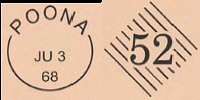 PM subtypes 4h-4M More square-like diamonds with finer lines possibly from 1863 onwards mostly in duplex form, including few extremely rare variations that can include letters Otherwise quite common.
PM subtypes 4h-4M More square-like diamonds with finer lines possibly from 1863 onwards mostly in duplex form, including few extremely rare variations that can include letters Otherwise quite common. Other unlisted variations exist, not relevant to this postmark-cover collection.





